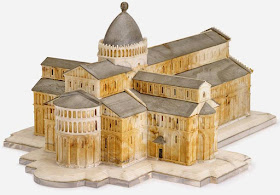Do you collect souvenir buildings made of alabaster? I’m going to
explore some non-metal ‘other materials’ in a series of posts Some alabaster
architectural miniatures are grand antiques like this model of the Cathedral at Pisa and other Grand Tour souvenirs, while others are still being made and
simple, like Egyptian pyramids. First question: What is alabaster?
In simple terms, It’s a fine-grained, translucent form of gypsum,
typically white or yellow, that is often carved. In lengthy terms, alabaster is
a name applied to varieties of two distinct minerals, when used as a material:
gypsum (a hydrous sulfate of calcium) and calcite, a carbonate of calcium, also
known as onyx-marble, Egyptian alabaster or Oriental alabaster. In geological
terms alabaster is "a stalagmitic limestone marked with patterns of
swirling bands of cream and brown.” In general, but not always, ancient
alabaster in Egypt and the Near & Middle East is calcite. Alabaster in
medieval Europe is gypsum. Modern alabaster is probably calcite, but may be
either. Both are easy to 'work’ and carve and as both are slightly
water-soluble, have been used for making a variety of indoor artworks and
carvings, as they will not survive long outdoors. TIP: don’t wash alabaster
with soap. If alabaster with a smooth, polished surface is washed with
dishwashing liquid, it will become rough, dull and whiter, losing most of its
translucency and luster. Here are some tips on how to clean alabaster. I
collect 3D metal souvenir buildings of all places and ages. If you have any to
sell or trade, contact me via my email address in the “complete profile” link
at the top right of this blog.







No comments:
Post a Comment